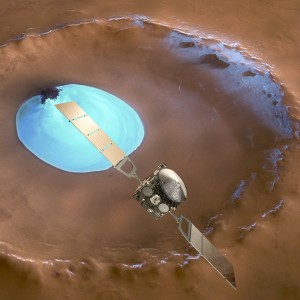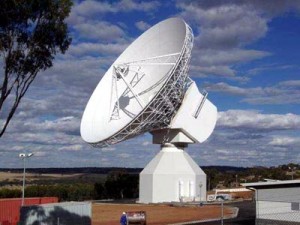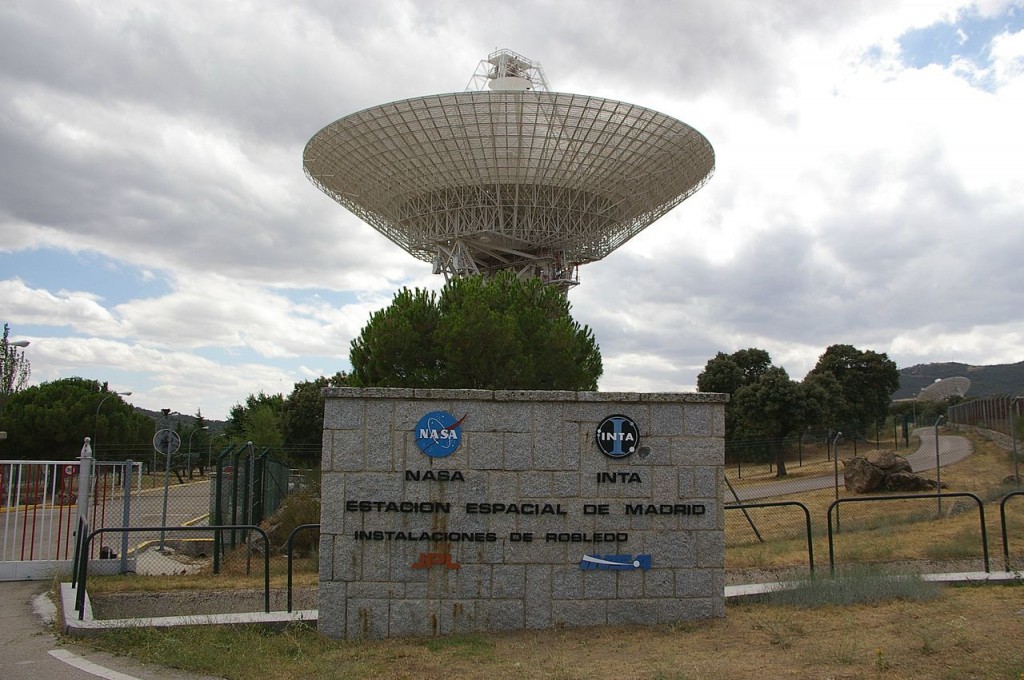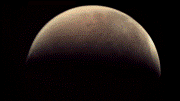Early in the morning (GMT time) on Sunday, 29 December, ESA’s Mars Express will make the closest-ever flyby of Phobos, one of Mars’ two moons.
The breathtakingly close passage will see Mars Express skim past the moon just 45 km from its surface and promises to provide valuable scientific insight into the unresolved origins of the two Martian moons, Phobos and Deimos (see Mars Express heading toward daring flyby of Phobos).
As the spacecraft passes close to Phobos, it will be pulled slightly off course by the moon’s gravity, changing the spacecraft’s velocity by no more than a few centimetres per second. These small deviations will be reflected in the spacecraft’s radio signals as they are beamed back to Earth, and scientists can then translate them into measurements of the mass and density structure inside the moon.
Earlier flybys, including the previous closest approach of 67 km in March 2010, have already suggested that the moon could be between a quarter and a third empty space – essentially a rubble pile with large spaces between the rocky blocks that make up the moon’s interior.
Knowing the structure of the roughly 27 x 22 x 18 km Phobos will help to solve a big mystery concerning its origin and that of its more distant sibling, Deimos, which orbits Mars at approximately three times greater distance.

Artist’s impression of Mars Express set against a 35 km-wide crater in the Vastitas Borealis region of Mars at approximately 70.5°N / 103°E. Credit: ESA/DLR/FU-Berlin-G.Neukum
The flyby is not only a scientific challenge, but also an operations one as well, which led our director general earlier this year to mention, ‘I hope that my colleagues at ESOC will prove that they are the best pilots‘.
In fact, Mars Express Spacecraft Operations Manager Michel Denis and the extended ‘team of teams’ responsible for MEX flight operations at ESOC – including the flight operations team, the flight dynamics experts and the ground tracking station specialists – are treating the flyby as a mini ‘mission within a mission’.
“For 35 hours around the time of closest approach [08:09 CET 29-12-13], MEX will conduct a science mission completely different from its routine and highly automated operations for observing Mars,” says Michel.
“Months of preparation will come to fruition, but the scientific prize will be worth the work.”
Here’s the skinny on how the flyby will work.
The basics
As mentioned above, to measure the gravity field of Phobos, scientists will use Mars Express itself as an instrument, measuring the very slight acceleration of the spacecraft as it passes by the small moon.
“In order to do this, however, we need to very precisely measure the orbit of Mars Express both before and after the flyby and so the ‘flyby mission’ will actually take place over five orbits of Mars for a total duration of about 32 hours,” says Andy Johnstone, MEX Spacecraft Operations Engineer at ESOC.
Andy explains that the acceleration acting on MEX will be detected by measuring the Doppler shift in the radio signals transmitted from the spacecraft, and this requires ESA to use multiple ground stations to provide constant coverage.

ESA’s first 35-metre deep-space ground station is situated at New Norcia, 140 kilometres north of Perth in Australia. Credit: ESA
Initial tracking will be provided by DSA 1, ESA’s 35m deep-space ground station at New Norcia, Australia. Then NASA will provide support with two of their 70m stations, DSS-63 near Madrid, Spain, and then DSS-14 in Goldstone, California.
Finally, Mars Express will be tracked again by New Norcia (we’ll provide a detailed timeline in a separate post).
Andy adds that, while it will not be possible to acquire images (using the High Resolution Stereo Camera – HRSC – on board MEX) during the flyby on 29 December, there are other (more distant) flybys on 21 December (fabulous image here) and 4 January where this will be possible (and necessary).

Front view of the Madrid Deep Space Network Complex, near the town of Robledo de Chavela. Credit: Hector Blanco de Frutos Creative Commons Attribution 2.5 license (cc-by)
What we’ve got to know
To be more specific, in order to determine with high accuracy the influence of the various regions of Phobos on the Mars Express orbit, and therefore the density of each region of Phobos, it is mandatory to know very exactly where the little moon and the little spacecraft are at any point in time.
So, while the flyby itself is instantaneous and the gravity of Phobos will only be ‘felt’ by MEX for just a few seconds, the extended ground-station tracking will reveal the Mars Express orbit extremely accurately.
Then, the images taken with the HRSC during the flybys on 21 December and 4 January will be used to determine extremely accurately the orbit of Phobos (by looking at the star background) around the flyby point.
“As Andy said, the acceleration we will measure from the Doppler shift in the signal from the spacecraft,” says James Godfrey, one of Andy’s colleagues on the MEX operations team at ESOC.
“There are already good figures for the ephemerides [orbital trajectory] of Phobos, so we know this within an accuracy of 1 km, but the HRSC images of Phobos on the closest approaches on 21 December and 4 January will be used to refine this.”
A few notes:
- The flight dynamics teams at ESOC already computed the orbit for this very close passage more than 18 months ago, and Mars Express has been conducting manoeuvres (thruster burns) every few months to reach the correct trajectory to ‘meet up’ with Phobos.
- Due to tiny perturbations of the actual orbit (with respect to the orbital models) accumulating over the past year, it was determined a few weeks ago that the flyby distance would, in fact, be a few kilometres larger than intended.
- As a result, an extra pair of manoeuvres was performed successfully on 9 December to bring MEX back as close as possible to the trajectory required by for the scientific aims of the flyby.




Discussion: 3 comments
Waiting for the flyby. All the very best.
Great piece – Thanks.
One question.
” it will not be possible to acquire images (using the High Resolution Stereo Camera – HRSC – on board MEX) during the flyby on 29 December,”
Why so? Relative speed at encounter to high?
Thanks
Hi Gurbir,
Reply from MEX Project Scientist Olivier Witasse below.
Cheers!
==============================
Yes – relative speed would be too high and require too high of a slew rate to be able to take good images. We could of course take images down to about 80-90 km distance, and then no images during the closest approach, but we decided instead to take advantage of the very close distance and also of the good geometry (favouring the Doppler effect) to perform the gravity experiment.
Cheers
Olivier